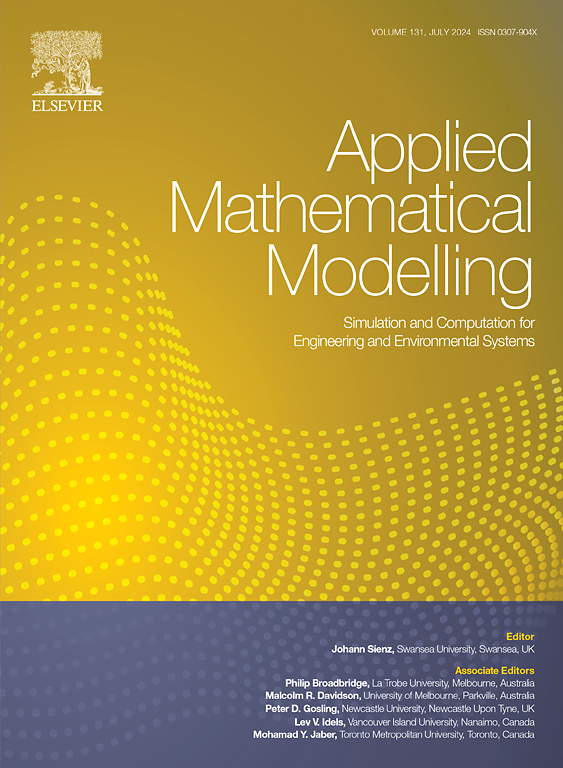Modelling for assessing the compulsory vaccination strategy against highly pathogenic avian influenza in a poultry farm of China
IF 4.4
2区 工程技术
Q1 ENGINEERING, MULTIDISCIPLINARY
引用次数: 0
Abstract
The prevalence of highly pathogenic avian influenza (HPAI) has become substantial obstacles for the poultry industry and international trade with potential threat to human health. We developed a data-driven transmission model for quantitatively assessing the risk of HPAI spread in a henhouse under the China national mandatory vaccination plan for prevention and control of HPAI in the poultry industry. With data from farm investigations and literature reviews, we calibrated our model to estimate some key model parameters. We employed the Latin Hypercubic Sampling (LHS) technique for multiple sampling during simulations and subsequently conducted statistical analysis to enhance the accuracy and reliability of our results. We found that within a designated single henhouse, regardless of whether the initial virus level is 5 or 500 times the minimum viral load required to trigger highly fatal avian influenza, when the virus transmission capacity is low (the basic reproductive number ), implementing mandatory vaccination measures according to the policy-stipulated timings will keep the average overall mortality rate of chickens with maternal antibodies within the range of 0.08 %-0.42 %. However, if the virus transmission capacity doubles, the loss of chickens will increase by 3–5 times, but it will still be significantly lower than the normal mortality rate (5 %). Therefore, to optimize post-vaccination management and control, we recommend monitoring flock antibodies regularly, evaluating vaccine effectiveness promptly, strengthening pathogen surveillance, and upgrading farm biosecurity level. These measures are essential for safeguarding flock immunity, facilitating early virus detection, and mitigating the risk of HPAI transmission.
为评估中国某家禽养殖场高致病性禽流感强制免疫策略建立模型
高致病性禽流感(HPAI)的流行已成为家禽业和国际贸易的重大障碍,对人类健康构成潜在威胁。我们开发了一个数据驱动的传播模型,用于定量评估在中国国家强制性疫苗接种计划下禽业预防和控制高致病性禽流感的鸡舍传播风险。根据农场调查和文献综述的数据,我们校准了我们的模型,以估计一些关键的模型参数。我们在模拟过程中采用拉丁超立方采样(LHS)技术进行多次采样,随后进行统计分析,以提高结果的准确性和可靠性。我们发现,在指定的单个鸡舍内,无论初始病毒水平是引发高致死率禽流感所需最低病毒载量的5倍还是500倍,当病毒传播能力较低时(基本繁殖数R0∈(2,3)),按照政策规定的时间实施强制性疫苗接种措施,将使携带母源抗体的鸡的平均总死亡率保持在0.08% - 0.42%的范围内。然而,如果病毒传播能力增加一倍,鸡的损失将增加3-5倍,但仍将显著低于正常死亡率(5%)。因此,为了优化疫苗接种后的管理和控制,我们建议定期监测群体抗体,及时评估疫苗有效性,加强病原体监测,提高农场生物安全水平。这些措施对于保障禽群免疫力、促进早期发现病毒和减轻高致病性禽流感传播风险至关重要。
本文章由计算机程序翻译,如有差异,请以英文原文为准。
求助全文
约1分钟内获得全文
求助全文
来源期刊

Applied Mathematical Modelling
数学-工程:综合
CiteScore
9.80
自引率
8.00%
发文量
508
审稿时长
43 days
期刊介绍:
Applied Mathematical Modelling focuses on research related to the mathematical modelling of engineering and environmental processes, manufacturing, and industrial systems. A significant emerging area of research activity involves multiphysics processes, and contributions in this area are particularly encouraged.
This influential publication covers a wide spectrum of subjects including heat transfer, fluid mechanics, CFD, and transport phenomena; solid mechanics and mechanics of metals; electromagnets and MHD; reliability modelling and system optimization; finite volume, finite element, and boundary element procedures; modelling of inventory, industrial, manufacturing and logistics systems for viable decision making; civil engineering systems and structures; mineral and energy resources; relevant software engineering issues associated with CAD and CAE; and materials and metallurgical engineering.
Applied Mathematical Modelling is primarily interested in papers developing increased insights into real-world problems through novel mathematical modelling, novel applications or a combination of these. Papers employing existing numerical techniques must demonstrate sufficient novelty in the solution of practical problems. Papers on fuzzy logic in decision-making or purely financial mathematics are normally not considered. Research on fractional differential equations, bifurcation, and numerical methods needs to include practical examples. Population dynamics must solve realistic scenarios. Papers in the area of logistics and business modelling should demonstrate meaningful managerial insight. Submissions with no real-world application will not be considered.
 求助内容:
求助内容: 应助结果提醒方式:
应助结果提醒方式:


